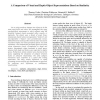Free Online Productivity Tools
i2Speak
i2Symbol
i2OCR
iTex2Img
iWeb2Print
iWeb2Shot
i2Type
iPdf2Split
iPdf2Merge
i2Bopomofo
i2Arabic
i2Style
i2Image
i2PDF
iLatex2Rtf
Sci2ools
IV
2005
IEEE
2005
IEEE
A Comparison of Visual and Haptic Object Representations Based on Similarity
Do we judge similarity between two objects to be the same using touch and vision? We investigated this using psychophysical experiments in which subjects rated the similarity between objects presented either visually or haptically. The stimuli were a family of novel, threedimensional objects whose microgeometry (“texture”) and macrogeometry (“shape”) were parametrically varied. Multidimensional scaling of the similarity data was used to reconstruct haptic and visual perceptual spaces. For both modalities, a two-dimensional perceptual space was found whose dimensions clearly corresponded to shape and texture. Interestingly, shape dominated in visual space, whereas both shape and texture were important in haptic space. Furthermore, stimuli clusters were observed in this space, suggesting the emergence of category structure based on similarity relationships. The same category boundaries were confirmed in a visual free sorting experiment. This study reveals differences in object p...
Information Technology | IV 2005 | Perceptual Space | Two-dimensional Perceptual Space | Visual Perceptual Spaces |
Related Content
| Added | 25 Jun 2010 |
| Updated | 25 Jun 2010 |
| Type | Conference |
| Year | 2005 |
| Where | IV |
| Authors | Theresa Cooke, Christian Wallraven, Heinrich H. Bülthoff |
Comments (0)

